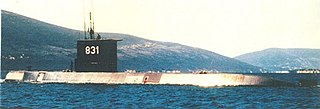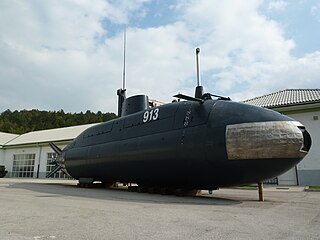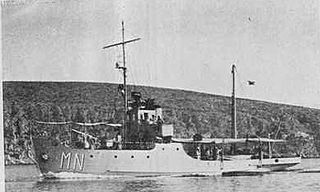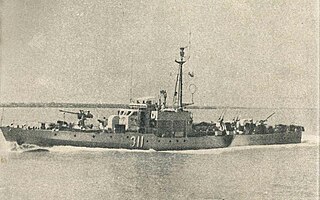
The Croatian Navy is a branch of the Croatian Armed Forces. It was formed in 1991 from what Croatian forces managed to capture from the Yugoslav Navy during the breakup of Yugoslavia and Croatian War of Independence. In addition to mobile coastal missile launchers, today it operates 30 vessels, divided into the Navy Flotilla for traditional naval duties, and the Croatian Coast Guard. Five missile boats form the Croatian fleet's main offensive capability.

Kralj Petar Krešimir IV is a Kralj-class missile boat in service with the Croatian Navy. It was laid down in 1990 at the Kraljevica Shipyard as the first ship in a new class being built for the Yugoslav Navy. As the Croatian War of Independence started gaining momentum, shipyard workers stalled the completion of the ship until the remaining Yugoslav forces retreated, preserving the ship for the Croatian Navy that was being formed.

The Yugoslav Navy, was the navy of Yugoslavia from 1945 to 1992. It was essentially a coastal defense force with the mission of preventing enemy landings along Yugoslavia's rugged 4,000-kilometer shoreline or coastal islands, and contesting an enemy blockade or control of the strategic Strait of Otranto.

The Myanmar Navy is the naval warfare branch of the armed forces of Myanmar. With 16,000 personnel on duty, the navy operates more than 227 vessels. Prior to 1988, the navy was small, and its role in counter-insurgency operations was smaller than those of the army and the air force. The navy has since been expanded to take on a more active role in defense of Myanmar's territorial waters.

The Kotor class are a pair of light frigates built for the Yugoslav Navy during the 1980s at the Kraljevica Shipyard in SR Croatia.

The Shershen class was the NATO reporting name for a class of torpedo boats built for the Soviet Navy and allies. The Soviet designation was Project 206 Shtorm.

The Heroj class was a class of diesel-electric attack submarines built for the Yugoslav Navy during the 1960s. The three strong class was the second generation of domestically built submarines, representing a significant improvement compared to the earlier Sutjeska class. Built at the Brodogradilište specijalnih objekata in Split, the new class featured a streamlined hull design and four bow facing torpedo tubes that could also be used for minelaying.

The Sava class was a class of diesel-electric attack submarines built for the Yugoslav Navy during the late 1970s and early 1980s. Developed by the Brodarski Institute (BI) from Zagreb, the two strong class was built by the Brodogradilište specijalnih objekata in Split. They were intended as a replacement for the aging Sutjeska-class submarines. Compared to the earlier Heroj class, the Sava class was longer with more powerful armament that consisted of six torpedo tubes that could also be used for minelaying.

Split was a Koni-class frigate in service with the Yugoslav Navy (JRM). Laid down and completed during the late 1970s as Sokol of the Soviet Navy, it was the fourth ship of a class that was being built by the Zelenodolsk Shipyard primarily for export to various friendly navies. The ship was acquired by the JRM in 1980 and commissioned as Split, becoming the second ship in JRM service to be named after the city of Split. It was soon followed by a second Koni-class hull, Koper (VPBR-32), commissioned in the JRM in 1982. Designated as a Large Patrol Boat by the JRM, Split's original armament consisting of naval guns, anti-submarine rocket launchers and anti-aircraft missiles was further improved by the addition of four P-20 anti-ship missiles, making it the most versatile ship in the JRM inventory at the time.

The Končar class is a class of six missile boats built for the Yugoslav Navy during the late 1970s at Tito's Shipyard Kraljevica, SR Croatia. The boats featured a mixture of Western and Eastern European equipment, including Soviet anti-ship missiles and Swedish guns.

The Kralj class is a class of two missile boats, one of which was on order for the SFR Yugoslav Navy and one of which, following the break-up of Yugoslavia, was built for the Croatian Navy. As of 2009 both vessels remain in service. It is an upgraded version of the Rade Končar missile boat class and is 8.5 metres (28 ft) longer. Kralj Petar Krešimir IV and its sister ship Kralj Dmitar Zvonimir are the only ships in their class. A potential third ship was under consideration in 1999, but the ship was never commissioned due to budget restraints.
The Mornar class consisted of two large patrol boats built for the Yugoslav Navy by the Tito's Shipyard in Kraljevica during the late 1950s and early 1960s. The boats were based on the Udarnik (PBR-581), a French-built Le Fougueux-class submarine chaser acquired in 1956. Both boats had an uneventful career and were deleted in 1992.

The Una-class submarine was a class of six midget submarines built for the Yugoslav Navy at the Brodogradilište specijalnih objekata during the 1980s. They were designed with the purpose of laying small minefields and transporting naval special forces, with or without their submersibles, in shallow waters that were inaccessible for larger submarines. Due to their mission profile that called for a small design as well as the need to stay undetected, they lacked torpedo armament and a generator for battery recharging.

Šibenik is a Končar-class missile boat in service with the Croatian Navy. It was built for the Yugoslav Navy at the Kraljevica Shipyard in the 1970s as Vlado Ćetković (RTOP-402). In 1991 during the early stages of the Croatian War of Independence it was captured by Croatian forces while being overhauled at the "Velimir Škorpik" shipyard in Šibenik.

Šolta is a Mirna-class patrol boat in service with the Croatian Navy. Completed during the 1980s as Mukos (PČ-176), it was the sixth ship of a class that was being built for the Yugoslav Navy in the Kraljevica Shipyard.

The Silba class is a class of three landing ships, also used as minelayers, built for the Yugoslav (JRM) and Croatian Navy (HRM) during the 1980s and 1990s. The ships were built at the Brodogradilište specijalnih objekata shipyard in Split with slight differences in armament configuration between the last two ships. By the time the Croatian War of Independence started, one ship was in service with the JRM while another was being completed.

Mališan was a CB-class midget submarine that served in the Yugoslav Navy from 1953 to 1957. Laid down in 1943 by the Caproni company in Milan as CB-20, she was ordered by the Italian Regia Marina for harbour defence and anti-submarine warfare tasks, but she was incomplete at the time of the Italian surrender in September 1943. The unfinished boat was captured by the Germans and completed by March 1944. Her main armament consisted of two 450-millimetre (17.7 in) external torpedo tubes located on the sides of the hull, and she had a crew of four. Handed over to the navy of the Italian Social Republic – a World War II German puppet state – she was captured by Yugoslav ground forces in the port of Pola at the end of the war. Repaired, she was commissioned by the JRM and used to train submariners as well as patrol boat crews in anti-submarine warfare. Following her brief Yugoslav service she was donated to the Technical Museum in Zagreb in 1959 as a museum ship.

The Albona class were mine warfare ships used by the Italian Regia Marina and Royal Yugoslav Navy. Fourteen ships were originally laid down between 1917 and 1918 for the Austro-Hungarian Navy as the MT.130 class. However, the end of World War I and the dissolution of Austria-Hungary left them incomplete until 1920, when three ships were finished for the Regia Marina. These ships were armed with two 76 mm (3 in) guns. An additional five ships were completed for the KM in 1931 as the Malinska or Marjan class, and were armed with a single 66 mm (2.6 in). All of the completed ships could carry 24 to 39 naval mines. The remaining ships were never completed.
Sava was a Flutto-class submarine in service with the Yugoslav Navy. Built by Cantieri Riuniti dell'Adriatico in Monfalcone during the Second World War, Sava was laid down and completed as Nautilo for service with the Italian Regia Marina.

The Kraljevica class was a class of large anti-submarine patrol boats built for the Yugoslav Navy during the 1950s. Built by the Tito's Shipyard in Kraljevica, the 24 boats of the class were built in two series, the first from 1951 until 1954 and the second from 1954 until 1957. Although similar in layout, boats of the second series featured a slightly larger displacement and more powerful machinery.











































